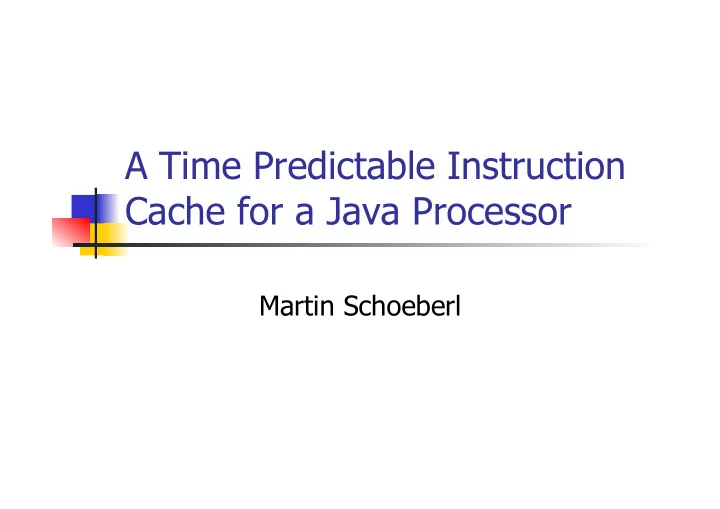

A Time Predictable Instruction Cache for a Java Processor Martin Schoeberl
Overview Motivation Cache Performance Java Properties Method Cache WCET Analysis Results Conclusion, Future Work JOP Method Cache 2
Motivation CPU speed – memory access Caches are mandatory Caches improve average execution time Hard to predict WCET values Cache design for WCET analysis JOP Method Cache 3
Execution Time t exe = (CPU clk + MEM clk ) x t clk CPU clk = IC x CPI exe MEM clk = Misses x MP clk = IC x Misses / Instruction x MP clk t exe = IC x CPI x t clk CPI = CPI exe + CPI IM + CPI DM H&P: CA:AQA JOP Method Cache 4
Misses per Instruction is too simple Architecture dependent (RISC vs. JVM) Different instruction length Different load/store frequencies Block size dependent Lower for larger blocks Memory access time Latency Bandwidth JOP Method Cache 5
Two Cache Properties MBIB and MTIB MBIB = Memory bytes read / Instruction byte MTIB = Memory transactions / Instruction byte Reflects main memory properties IM clk / IB = MTIB x Latency + MBIB / Bandwidth CPI IM = IM clk / IB x Instruction length JOP Method Cache 6
JVM Properties Short methods Maximum method size is restricted No branches out of or into a method Only relative branches JOP Method Cache 7
Method Sizes (rt.jar) JOP Method Cache 8
Bytecodes for a Getter Method private int val; public int getVal() { return val; } public int getVal(); Code: 0: aload 0 1: getfield #2; // Field val:I 4: ireturn JOP Method Cache 9
Method Sizes (rt.jar) JOP Method Cache 10
Method Sizes cont. Runtime library rt.jar (1.4): 71419 methods Largest: 16706 Bytes 99% <= 512 Bytes Larger methods are class initializer Application - javac: 98% <= 512 Bytes JOP Method Cache 11
Proposed Cache Solution Full method cached Cache fill on call and return Cache misses only at these bytecodes Relative addressing No address translation necessary No fast tag memory JOP Method Cache 12
Single Method Cache Very simple WCET foo() { analysis a(); High overhead: b(); } Partially executed Block 1 Cache method foo() foo load Fill on every call and a() a load return return foo load b() b load return foo load JOP Method Cache 13
Two Block Cache One method per foo() { block a(); Simple WCET b(); analysis } Block 1 Block 2 Cache LRU replacement foo() foo - load 2 word tag memory a() foo a load return foo a hit b() foo b load return foo b hit JOP Method Cache 14
Variable Block Cache b Whole method loaded Cache is divided in blocks Method can span several blocks foo a Continuous blocks for a method a Replacement b LRU not useful b Free running next block counter Stack oriented next block Tag memory: One entry per block JOP Method Cache 15
WCET Analysis Single method Trivial – every call, return is a miss Simplification: combine call and return load Two blocks: Hit on call: Only if the same method as the last called – loop Hit on return: Only when the method is a leave in the call tree – always a hit JOP Method Cache 16
WCET Analysis Var. Blocks Part of the call tree Method length determines cache content Still simpler than direct-mapped Call tree instead of instruction address Analysis only at call and return Independent of link addresses JOP Method Cache 17
Caches Compared Embedded application benchmark Cyclic loop style Simulation of external events Simulation of a Java processor (JOP) Different memory systems: SRAM: L = 1 cycle, B = 2 Bytes/cycle SDRAM: L = 5 cycle, B = 4 Bytes/cycle DDR: L = 4.5 cycle, B = 8 Bytes/cycle JOP Method Cache 18
Direct-Mapped Cache Plainest WCET target, size: 2KB Line MBIB MTIB SRAM SDR DDR size 8 0.17 0.022 0.11 0.15 0.12 16 0.25 0.015 0.14 0.14 0.10 32 0.41 0.013 0.22 0.17 0.11 MBIB = Memory bytes read / Instruction byte Memory read in clock cycles / Instruction byte MTIB = Memory transactions / Instruction byte JOP Method Cache 19
Fixed Block Cache Cache size: 1, 2 and 4KB Type MBIB MTIB SRAM SDR DDR Single 2.31 0.021 1.18 0.69 0.39 Two 1.21 0.013 0.62 0.37 0.21 Four 0.90 0.010 0.46 0.27 0.16 MBIB = Memory bytes read / Instruction byte Memory read in clock cycles / Instruction byte MTIB = Memory transactions / Instruction byte JOP Method Cache 20
Variable Block Cache Cache size: 2KB Block MBIB MTIB SRAM SDR DDR count 8 0.73 0.008 0.37 0.22 0.13 16 0.37 0.004 0.19 0.11 0.06 32 0.24 0.003 0.12 0.08 0.04 64 0.12 0.001 0.06 0.04 0.02 JOP Method Cache 21
Caches Compared Cache size: 2KB Type MBIB MTIB SRAM SDR DDR VB 16 0.37 0.004 0.19 0.11 0.06 VB 32 0.24 0.003 0.12 0.08 0.04 DM 8 0.17 0.022 0.11 0.15 0.12 DM 16 0.25 0.015 0.14 0.14 0.10 JOP Method Cache 22
Summary Two cache properties: MBIB & MTIB JVM: short methods, relative branches Single Method cache Misses only on call and return Caches compared Embedded application Different memory systems JOP Method Cache 23
Future Work WCET analysis framework Compare WCET values with a traditional cache Different replacement policies Don‘t keep short methods in the cache JOP Method Cache 24
Further Information Reading JOP Thesis: p 103-119 Martin Schoeberl. A Time Predictable Instruction Cache for a Java Processor. In Workshop on Java Technologies for Real-Time and Embedded Systems (JTRES 2004) , 2004. Simulation …/com/jopdesign/tools Hardware …/vhdl/core/cache.vhd …/hdl/memory/mem_sc.vhd JOP Method Cache 25
Recommend
More recommend